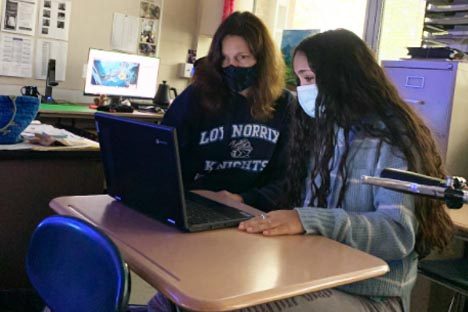Students and teachers weigh in on grading bias

Credit: Macy Daniels
Nayssa Quinones, a junior at Loy Norrix high school is working with Christina Homes a teacher, in AP spanish. Quinones is working on a final project for this trimester. “She is one of the sweetest teachers I have ever had, and she really cares about her students, “Quinones said.
November 10, 2021
Getting a good grade on an assignment is something many students strive for. Biased grading can create problems in school for students and teachers.
Junior Naysa Quinones, senior Kylie Kilgo and freshman Haneef Hampton have all expressed their opinions on biased grading. Valerie Long, an environmental science and biology teacher at Loy Norrix, explains her experience with biased grading.
The word biased means having an unfair tendency to think that some people, ideas, thoughts, etc., are superior to others.
Quinones, Kilgo and Hampton all agree that teachers have graded them based on how much they have liked or disliked students.
“I think that teachers have graded me better based on my performance in class,” said Hampton.
A study from anonymous exams found a 10% lead in students’ grades for students that seemed more likable, BBC news reported.
“I believe students’ social interaction performance in class has a higher intellectual effect, so yes, they are graded higher based on that interaction,” said Long.
Hampton and Quinones have observed that their peers have received better grades from a teacher because they are favored in the class.
“There have been times where I’ve worked on assignments with friends, and our work was almost the same, but one of us got a significantly better or worse grade,” said Quinones.
“I use the rubrics to assess the understanding but also try to give the students individual tasks as well as their group tasks to decipher between group work and personal effort,” Long explained.
According to the article, “Poll: Americans trust teachers, but don’t want their child to become one,” from Azed News, about 61% of U.S. citizens trust public school teachers.
Kilgo describes how she has faith in her teachers, but it can be hard when sometimes she does not agree with the grades she gets on assignments.
“If there is a student who consistently goes above and beyond what’s asked, always gets their work turned in on time, with consistent good grades, and regularly participates in class, and this student has a rough day or week and does poorly on an assignment, the teacher should be able to recognize that that’s not like them and maybe give some leniency,” Quinones said.
Kilgo thinks biased grading occurs by accident at times, but she would try to limit it as much as she could if she was a teacher.
Long covers up the names of students’ when grading work to remain as unbiased as possible
“I am unintentional to over-identify marks on their work so I can be as unbiased as possible,” said Long.










